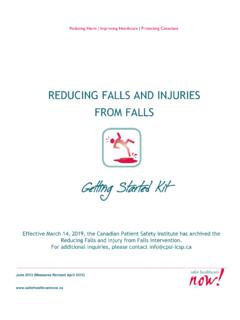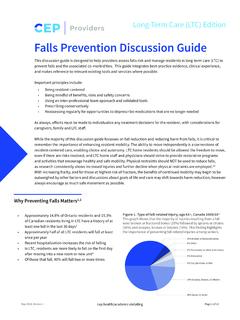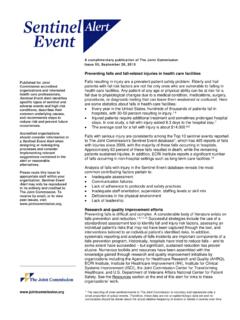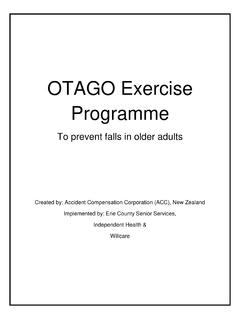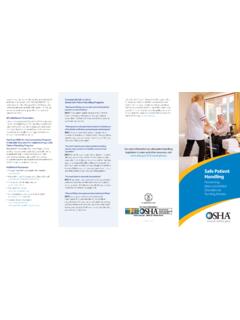Transcription of NATIONAL ACTION PLAN for CHILD INJURY PREVENTION
1 NATIONAL ACTION plan for CHILD INJURY PREVENTIONAn Agenda to Prevent Injuries and Promote the Safety of Children and Adolescents in the United StatesThe NATIONAL ACTION plan for CHILD INJURY PREVENTION is a publication of the NATIONAL Center for INJURY PREVENTION and Control of the Centers for Disease Control and for Disease Control and PreventionThomas R. Frieden, MD, MPH, DirectorNational Center for INJURY PREVENTION and ControlLinda C. Degutis, DrPH, MSN, DirectorDivision of Unintentional INJURY PreventionGrant T. Baldwin, PhD, MPH, DirectorSuggested citation: Centers for Disease Control and PREVENTION , NATIONAL Center for INJURY PREVENTION and Control. NATIONAL ACTION plan for CHILD INJURY PREVENTION . Atlanta (GA): CDC, NCIPC; Department of Health and Human ServicesCenters for Disease Control and PreventionNational Center for INJURY PREVENTION and ControlAn Agenda to Prevent Injuries and Promote the Safety of Children and Adolescents in the United StatesNATIONAL ACTION plan for CHILD INJURY PREVENTION2012E very day in the United States, two dozen children die from an INJURY that was not intended.
2 Such tragedy often leaves families broken apart and changes the lives of those left behind. INJURY deaths, however, are only part of the picture. Each year, millions of children in the United States are injured and live with the consequences of those injuries. These children may face disability and chronic pain that limit their ability to perform age-appropriate everyday activities over their lifetime. These deaths and injuries need not occur because they often result from predictable events. The good news is that we have solutions that work to prevent CHILD INJURY . The challenge is to apply what we know and work together to prevent these unnecessary tragedies to children, families, and help address this challenge, we introduce the NATIONAL ACTION plan for CHILD INJURY PREVENTION . It complements reports about CHILD INJURY from the World Health Organization/UNICEF and the Centers for Disease Control and Prevention1, 2, 3 and is the next logical step to address this challenge in the United plan is an overarching framework to guide the actions of those responsible for the health and safety of children and adolescents, including federal, state, and local agencies, philanthropies, and non-governmental organizations.
3 Additional stakeholders include schools, CHILD care centers, insurers, businesses, the media, medical institutions, policymakers and health care providers. CHILD INJURY PREVENTION is achievable. Although the United States has seen declines in many INJURY causes over the past 25 years, more progress is needed. This plan is intended to spark ACTION across the nation in many areas to help children grow and thrive without injuries. Safety should be a human right. Let us redouble our efforts to achieve this vision. Grant T. Baldwin, PhD, MPHD irector, Division of Unintentional INJURY PREVENTION NATIONAL Center for INJURY PREVENTION and Control Centers for Disease Control and PreventionPrefaceExecutive SummaryBackgroundStrategic FrameworkDomainsData and SurveillanceResearchCommunicationEducati on and TrainingHealth Systems and Health CarePolicyReferencesAcknowledgementsGoal s and Actions SummaryTable of Contentsi915313541455157636771798 EXECUTIVE SUMMARYN ational ACTION plan for CHILD INJURY PREVENTION | 20129 IntroductionChildhood unintentional injuries are the leading cause of death among children ages 1 to 19 years, representing nearly 40 percent of all deaths in this age group.
4 Each year, an estimated million children and teens from birth to age 19 are treated in emergency departments (EDs) for unintentional injuries and more than 9,000 die as a result of their injuries one every hour. Common causes of fatal and nonfatal unintentional childhood injuries include: drowning, falls, fires or burns, poisoning, suffocation, and transportation-related injuries. Injuries claim the lives of 25 children every day. While tragic, many of these injuries are predictable and preventable. Diverse segments of society are involved in addressing preventable injuries to children; however, until now, no common set of NATIONAL goals, strategies, or actions exist to help guide a coordinated NATIONAL effort. More than 60 partners joined the NATIONAL Center for INJURY PREVENTION and Control s (NCIPC) Division of Unintentional INJURY PREVENTION (DUIP) in developing the NATIONAL ACTION plan for CHILD INJURY PREVENTION (NAP) to provide guidance to the nation.
5 The overall goal of the NAP is to lay out a vision to guide actions that are pivotal in reducing the burden of childhood injuries in the United States and to provide a NATIONAL platform for organizing and implementing CHILD INJURY PREVENTION activities in the future. The NAP provides a roadmap for strengthening the collection and interpretation of data and surveillance, promoting research, enhancing communications, improving education and training, advancing health systems and health care, and for strengthening policy. Elements of the plan can inform actions by cause of INJURY and be used by government agencies, non-governmental organizations, the private sector, not-for-profit organizations, health care providers, and others to facilitate, support, and advance CHILD INJURY PREVENTION efforts. Burden Every year, nearly 9 million children ages 0 19 are treated for injuries in emergency departments and more than 225,000 require hospitalization at a cost of around $87 billion in medical and societal costs related to childhood injuries.
6 CHILD and adolescent uninten-tional INJURY deaths have not declined to the same extent as other diseases have, and resources directed at reducing CHILD INJURY are not commensurate with the burden it poses. Vulnerable Populations Like diseases, injuries do not strike randomly. Males are at higher risk than females. Infants are injured most often by suffocation. Toddlers most frequently drown. As chil-dren age, they become more vulnerable to traffic injuries. Motor vehicle injuries dominate among teens. Poverty, crowding, young maternal age, single parent households, and low maternal educational status all confer risk and make children more vulnerable to INJURY . Death rates are highest for American Indians and Alaska Natives and lowest for Asians or Pacific Islanders. States with the lowest INJURY rates are in the northeastern part of the United States. EXECUTIVE SUMMARY10 EXECUTIVE SUMMARYAn INJURY PREVENTION FrameworkOne framework for reducing childhood injuries is based on the public health model a model that is used for preventing many other diseases.
7 The public health approach includes identifying the magnitude of the problem through surveillance and data collection, identifying risk and protective factors, and, on the basis of this information, developing, implementing, and evaluating interventions, and promoting widespread adoption of evidence-based practices and can be implemented during various time frames before, during, or after an adverse event. Safety latches on medicine cabinets provide protection before an INJURY event, CHILD safety seats minimize INJURY during the INJURY -causing event, and effective emergency response speeds treatment and improves outcomes after an INJURY event has of the PlanThe NAP lays out a vision to guide actions that are pivotal in reducing the burden of childhood injuries in the United States and will be relevant to all those with an interest in children s health and safety, including: federal, state, and local agencies philanthropies, businesses and non-governmental organizations schools, educators, insurers, and health care providers policymakersThe plan is intended to help align priorities, to capitalize on existing strengths, to fill gaps, and to spark ACTION across the nation that will result in measurable reductions in death and disability, and diminish the financial and emotional burden of childhood injuries in families and society.
8 This outcome can only be realized if relevant stakeholders act on the plan . PREVENTION Opportunity While implementing the plan can potentially prevent many injuries to children and adolescents, the focus was on actions that would influence those injuries that are most burdensome to society, those for which there are feasible evidence-based interventions, those for which outcomes can be most easily measured, and those for which partners and stakeholders are likely available. Such injuries include: motor vehicle-related suffocation drowning poisoning fires/burns falls sports and recreationNational ACTION plan for CHILD INJURY PREVENTION | 201211 Six DomainsThe NAP is structured across six domains, which comprise a blueprint for ACTION . Each domain, summarized below, consists of three to five goals. The actions recommended in each goal lay out broad areas for improvement. CDC and its partners will work together to identify implementation strategies for these actions by type of and SurveillanceSystematic surveillance is essential for accurate needs assessment.
9 Only with good data can one estimate the relative magnitude of problems in order to set priorities. Current data collection systems are imperfect and incomplete. Better data can lead to better decisions, increased effectiveness (doing what works) and efficiency (avoiding waste). This plan calls for better data standardization (so that it is comparable across geography and time), better data quality (so that it is reliable and believable), and filling gaps (information about circumstances of INJURY events, outcomes, costs, and information that is local and community-specific). Information systems must allow for making existing data more available to those who can use and share it to design and implement interventions. Some of the actions include developing an online access to key databases, collecting better data on the costs of INJURY , improving links between police, hospital, and emergency department data, and standardizing data collection and reporting.
10 ResearchFor more than four decades, the scientific study of childhood injuries has paid rich dividends. Effective interventions such as bike helmets, four-sided pool fencing, booster seats, smoke alarms, concussion guidelines, and teen driving policies have already saved many lives. Additional research to improve our PREVENTION efforts will be required to further drive down CHILD INJURY rates and is needed at three different levels: 1) foundational research (how injuries occur), 2) evaluative research (what works and what doesn t work to prevent injuries), and 3) translational research (how to put proven INJURY PREVENTION strategies into ACTION throughout the nation). Because research is a shared public, academic, and private endeavor, better coordination of research efforts will minimize waste and maximize return. Research can also help reduce health disparities through better understanding of the relationship between injuries and factors such as socioeconomic status, demographics, race and ethnicity.










